AI-generated content, especially when created with mainstream AI tools, is often technically correct – but rarely perfect. It can be repetitive, superficial, and above all, it tends to sound artificial.
That’s where content humanization comes in.
The goal of this process is to significantly enhance the quality of AI content by making it sound more natural, relevant, and emotionally engaging. When done well, it improves both user experience and search engine performance.
Let’s dig in.
What Does It Mean to Humanize AI Content?
Anyone who’s spent some time working with AI can usually spot AI-generated text at first glance.
How? Just take a look:
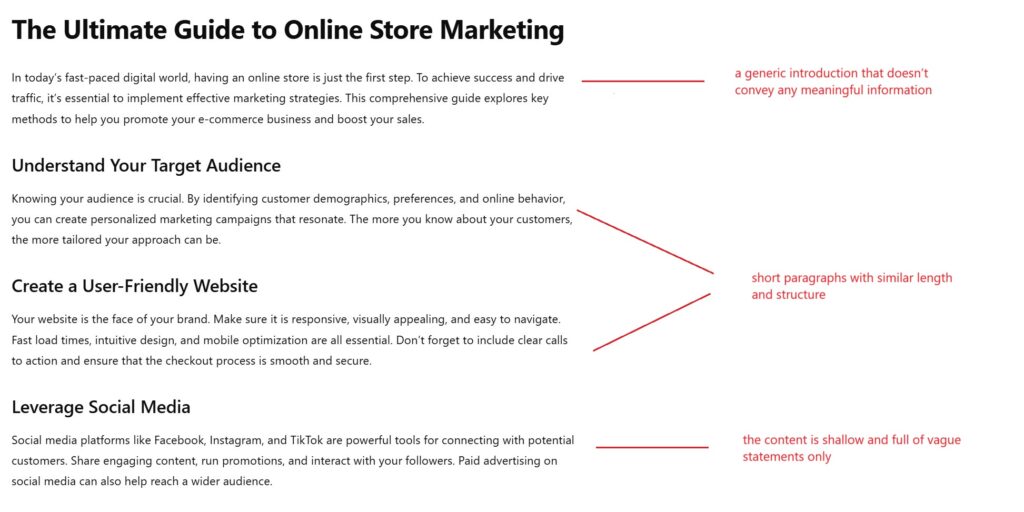
AI-generated content is often:
- Generic and repetitive
- Filled with similar phrases and sentence structures
- Lacking in-depth analysis
- Unnatural in transitions between paragraphs
- Over-reliant on bullet points
There are also the typical phrases that AI loves to repeat – like “in today’s world,” “a key aspect,” or “in a rapidly changing environment.” Sounds familiar?
Humanizing such content means:
- Adapting the language to your target audience and brand identity
- Eliminating clichés and overly formulaic expressions
- Adding emotional nuance and the author’s perspective
- Ensuring a logical structure and natural sentence rhythm
- Improving overall narrative flow and consistency
You can do it manually—by a copywriter or editor – or automatically, using advanced AI models. The best results come when you combine both approaches.
Why Bother Humanizing AI Text?
Whether you’re creating content designed to rank in Google or posts meant to drive engagement on social media, your number one goal should always be to deliver value.
That’s nearly impossible if your content isn’t reader-friendly.
By humanizing AI-generated text, you:
- Maintain a consistent tone and quality across all your content
- Improve the natural flow and clarity of your writing
- Avoid being flagged – by AI detectors or sharp-eyed readers
- Enhance your SEO performance – Google favors content with clear structure, natural language, and unique, engaging elements
How to Effectively Humanize AI-Generated Content
Humanizing AI content doesn’t just happen during editing – it actually starts with the prompt. How you craft it has a massive impact on the final result.
Below you will find 10 actionable tips that will help you get more natural, engaging, and trustworthy content when working with AI.
1. Start with a Strong Prompt
If you want better output, you need a better input. A well-thought-out prompt sets the tone, defines the structure, and gives the AI a clear path to follow.
Here’s what to include in a strong prompt:
- Audience – Who is this for?
- Goal – What should this content do – inform, convert, entertain, explain?
- Tone – Formal? Conversational? Expert? Friendly?
- Stylistic guidance – Vary sentence lengths, include bullet points, add tables, etc.
- Words to avoid – Some brands want to steer clear of terms like “luxury” or “disruptive.”
- Examples to follow – Include links or short samples to emulate.
👉 Let’s look at a simple example: Prompt 1: “Write an article about how to choose a bike chain.” → Output: Basic, generic.
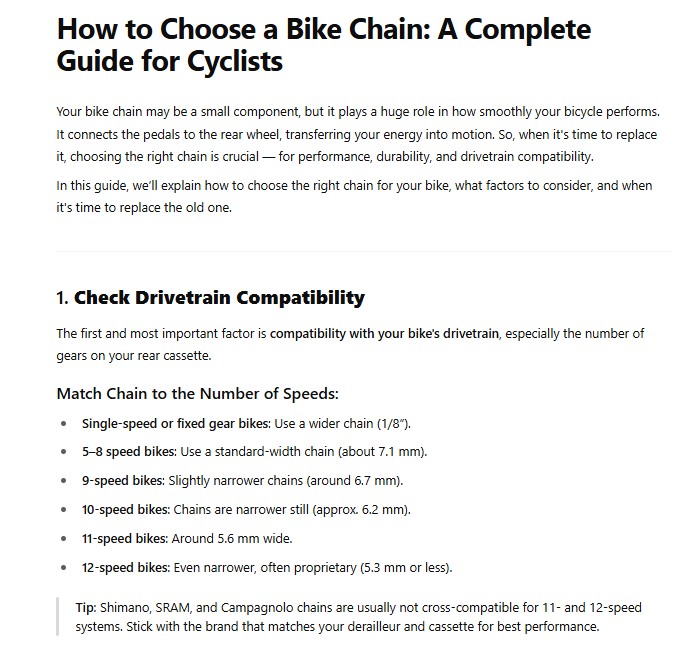
Prompt 2: “Write a blog post on how to choose a bike chain for experienced road cyclists. The tone should be casual and engaging. Use varied sentence structures and formatting (lists, tables, etc.). Avoid using the word ‘key.’ Include practical tips.” → Output: Much closer to what you’d actually publish.
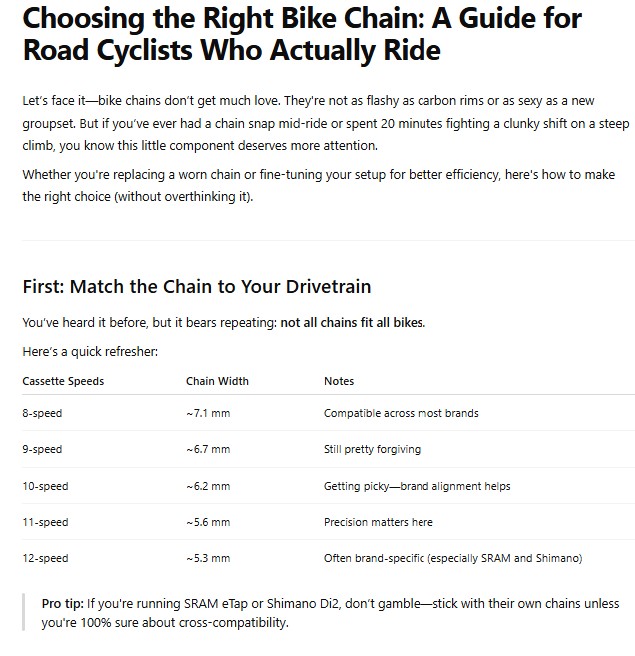
2. Fact-Check and Add Up-to-date Info
AI isn’t always up-to-date. What’s more, sometimes it even invents facts. This is called hallucination.
One of the most reliable ways to avoid it is with Retrieval-Augmented Generation (RAG), which pulls info from trusted sources before writing.
👉 Senuto Enterprise uses RAG to boost accuracy and reduce misinformation.
If you’re not using a RAG-based tool:
- Manually double-check all facts.
- Provide AI with fresh, accurate data up front.
- Ask for sources to make validation easier.
3. Add a Human Touch
Most AI-generated content feels fine at first glance – but “fine” isn’t enough. When you look closer, it’s often shallow, generic, and repetitive.
Make it more human by including:
- Personal stories or reflections
- Anecdotes and real-life examples
- Metaphors or analogies
- A clear author perspective
👉 It’s not just for your readers – Google’s E-E-A-T framework values unique, experience-based insights over SEO rewrites.
4. Use a Personal Tone (When Appropriate)
AI can mimic your tone – if you teach it. Share samples of your writing in the prompt, or ask it to follow a particular text’s voice.
Prompt that you can use: “Analyze the tone of this article: [link]. Write a new post on [topic] in a similar style, with comparable sentence structure, pacing, and personality”.
👉 You can also include content from your “About” page or case studies to give AI more context about your voice and expertise.
5. Try Humanizing Tools
Yes, you can use AI to make AI sound less like… AI. Tools like Senuto’s ReWriter are designed to rephrase content in a more human, natural way.
Here’s what these tools can do:
- Rework sentences to improve flow and readability
- Vary structure, paragraph length, and tone
- Add conversational language and cut out generic phrasing
- Remove repetition and awkward patterns
See before-and-after samples using ReWriter, plus its AI detection results to track improvement.
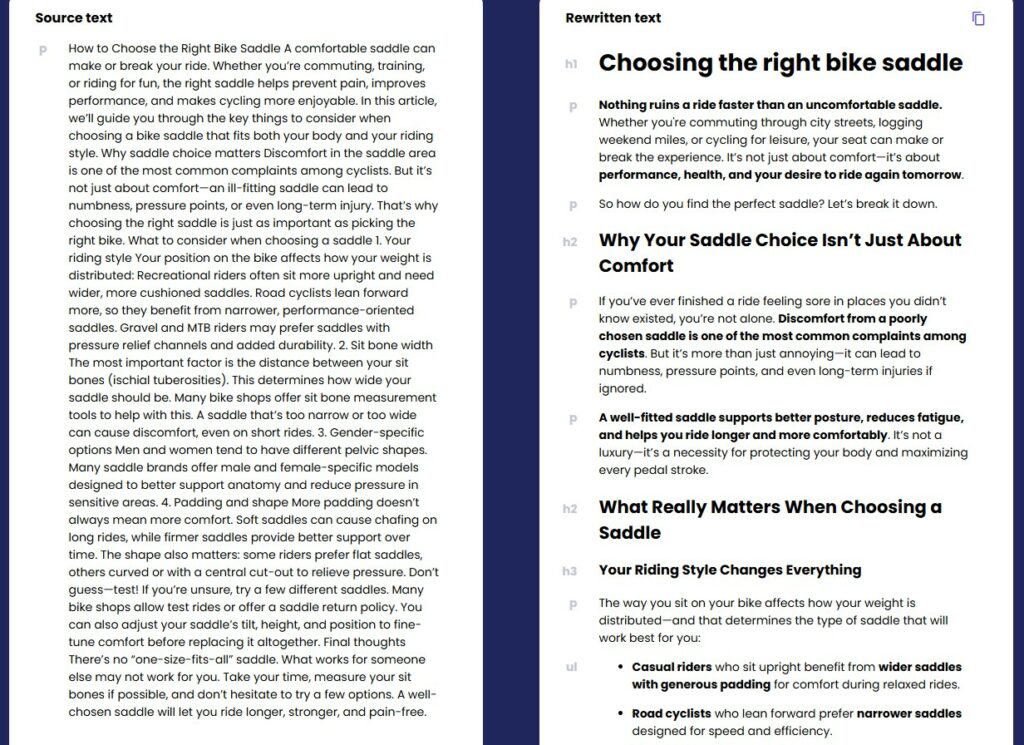
6. Be Ruthless About Clarity
AI loves filler. Readers don’t. Get to the point quickly and cut anything that doesn’t add value.
Try prompting: “Edit this for clarity and flow. Keep it sharp and reader-friendly – no filler, no repetition, no empty phrases.”.
7. Switch Up the Rhythm
Nothing screams “AI-generated” like identical paragraph lengths and copy-paste sentence structures. Want the writing to feel human? Give it rhythm and texture.
Here’s how:
- Vary paragraph length
- Ask questions to engage the reader
- Break up dense blocks with lists or visuals
- Mix up sentence structure and pacing
If you want the AI to help with formatting, say so in the prompt. Set the tone, structure, and style expectations up front.
8. Ditch the Passive Voice
Passive voice drains energy from your writing – and AI loves it.
You’ll see lines like:
- “The product was launched…”
- “The article was written…”
Flip them into active voice for stronger, clearer sentences:
- “We launched the product.”
- “I wrote the article.”
👉 Prompt tip: Add “Use active voice. Avoid passive constructions unless necessary.”
Want to go further? Include side-by-side examples so the AI knows what you’re aiming for.
9. Use AI Tools Built for Writers
General-purpose chatbots can get the job done – but if you’re serious about content, SEO-focused tools will take you further.
Take AI Writer for example. It:
- Builds content using expert-level, context-aware prompts
- Lets you customize structure before the draft even starts
- Pulls insights from top-ranking pages on Google for smarter optimization
10. Don’t Overthink AI Detectors
Worried your content won’t pass as human? Don’t be. AI detectors are wildly inconsistent – and not exactly reliable.
A blog post I wrote by hand in 2020 got flagged as 64% AI. No bots involved. Just… my writing style.
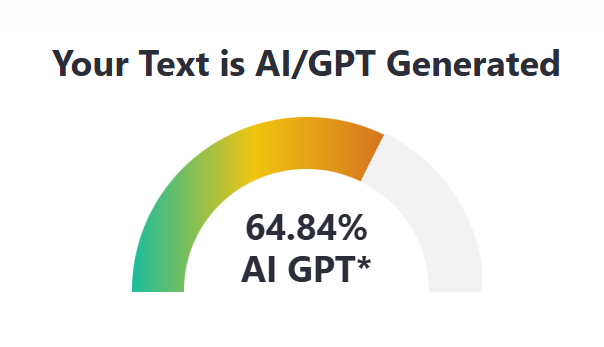
Here’s what actually matters:
- Is the content helpful?
- Does it sound authentic?
- Will it serve your audience?
If the answer is yes, you’re doing it right. Google (and your readers) care more about value than a score from some glitchy classifier.
Is Humanization Really Necessary to Rank in Google?
The short answer? It depends – but mostly yes.
According to Google’s current guidelines, it doesn’t matter whether your content was written by a human or generated by AI. What matters is the quality. As stated clearly:
Our focus on the quality of content, rather than how content is produced.
That said, here’s the catch: if your AI-assisted content doesn’t meet a high standard, you’ll need to improve your prompts or polish the text manually. Because at the end of the day, Google favors content that delivers genuine value.
To succeed in organic search, your content should align with Google’s E-E-A-T principles – Experience, Expertise, Authoritativeness, and Trustworthiness – regardless of who or what created it.
That means your content should:
- Offer unique insights, research, or thoughtful analysis
- Cover the topic in depth, from multiple perspectives
- Reference credible sources
- Avoid simply paraphrasing the top search results
- Be attributed to a real person with relevant expertise
- Speak directly to real user needs
- Be free from factual mistakes and grammatical slip-ups
- Prioritize the reader’s experience, not just search algorithms
- Be written with care and intention, not churned out at scale
In that sense, humanization isn’t optional – it’s part of what makes your content rank-worthy.
Final Thoughts
AI can supercharge your writing workflow. It speeds up research, helps structure ideas, and takes you from concept to draft faster than ever.
But no matter how advanced the tool, every piece of AI-generated content still needs you. The human touch matters. Even with strong prompts and smart software, it’s your job to fact-check, fine-tune, and make sure the result actually feels like something a person wrote.
AI is your co-pilot – but you’re the one flying the plane.
Make sure what you publish sounds like it came from a human, not just a prompt.
Good luck out there 🚀
 Katarzyna Kwartnik
Katarzyna Kwartnik